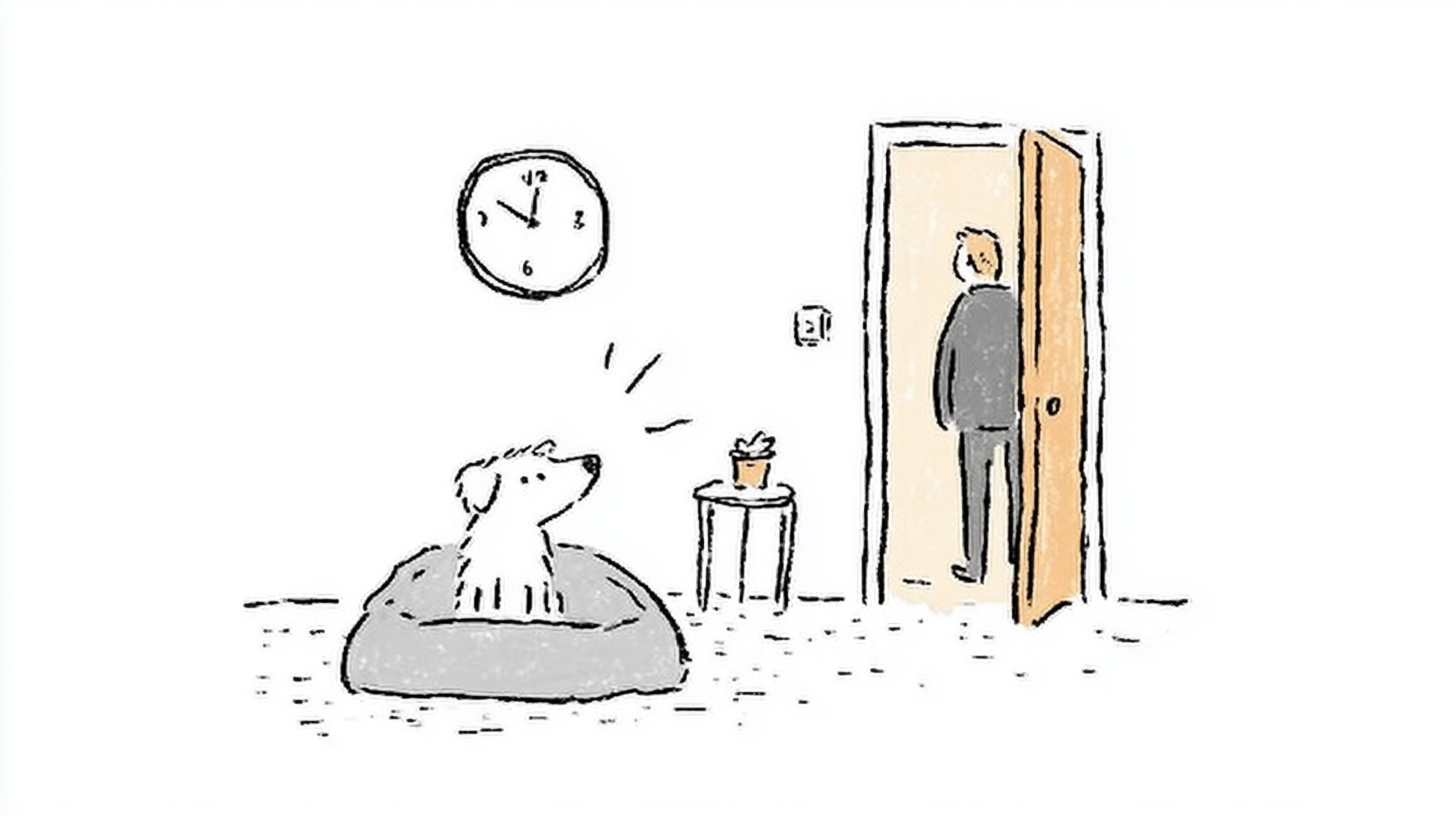Puppy Separation Anxiety Training Schedule: A Step-by-Step Guide
Bringing home a new puppy fills your heart with joy, but it also comes with important responsibilities. One of the most crucial skills you'll teach your furry friend is how to feel comfortable and secure when alone. By following a structured training schedule, you can prevent separation anxiety from developing and set your puppy up for a lifetime of confidence.
Why Prevention Matters
Puppy separation anxiety is far easier to prevent than to address months or years later. Research from the Generation Pup longitudinal study (2024) found that nearly half of puppies (46.9%) develop separation-related behaviors by 6 months without proper training. Those early weeks and months shape your puppy's understanding of the world and their place in it. By being proactive with separation training, you're:
- •Building confidence from the start
- •Preventing destructive behaviors
- •Creating positive alone-time associations
- •Establishing healthy independence
- •Reducing stress for both you and your puppy
Before You Begin: Setting Up for Success
Create a Safe Haven
Your puppy needs a designated space for alone time. This could be:
- •A puppy-proof room
- •A comfortable crate (if crate trained)
- •A secured exercise pen
Ensure this space is:
- •Free from hazards (electrical cords, small objects)
- •Equipped with fresh water
- •Comfortable with appropriate bedding
- •Associated with positive experiences
Gather Your Training Tools
- •High-value treats
- •Puzzle toys and enrichment activities
- •A consistent "departure cue" phrase
- •Camera or monitor (optional but helpful)
- •Patience and consistency
Your Week-by-Week Training Schedule
Week 1: Building Positive Associations (Days 1-7)
Goal: Make the safe space a happy place
Daily Activities:
- •Feed all meals in the designated space
- •Play games and offer treats in the area
- •Allow free access – let your puppy explore voluntarily
- •Practice 5-10 second separations with door open
- •Reward calm behavior generously
Success Tip: Never use the space as punishment. Keep all associations positive.
Week 2: Basic Separation Skills (Days 8-14)
Goal: Introduce brief separations with barriers
Daily Training:
- •
Same-Room Separations (3-5 times daily)
- •Use baby gates to create separation
- •Give your puppy a special toy or treat
- •Stay visible but don't interact
- •Start with 30 seconds, build to 2-3 minutes
- •Only return when puppy is calm
- •
Door Training (2-3 times daily)
- •Close door for 1-3 seconds
- •Say "yes" and treat through the door
- •Gradually increase to 10 seconds
- •Mix short and longer durations
Remember: Progress at your puppy's pace. If they show stress, take a step back. Interestingly, the 2024 Generation Pup study found that puppies who were restricted to crates or rooms overnight at 16 weeks or younger were less likely to develop separation anxiety - supporting this gradual approach.
Week 3: Adding Distance (Days 15-21)
Goal: Practice being out of sight
Training Progression:
- •
Step Away from Door
- •Close door, take one step back
- •Return immediately with praise
- •Gradually increase distance
- •Practice 5-10 times per session
- •
Out of Sight Training
- •Use your departure cue: "I'll be right back"
- •Step out of sight for 1 second
- •Return before puppy gets anxious
- •Build duration slowly
Key Milestone: Puppy remains calm for 30 seconds while you're out of sight.
Week 4: Building Duration (Days 22-28)
Goal: Extend alone time gradually
Daily Schedule:
- •Morning: 5-minute separation during breakfast
- •Midday: Two 10-minute practice sessions
- •Evening: One 15-minute session with enrichment
Training Tips:
- •Vary the duration (don't always increase)
- •Add background noise (TV, music)
- •Provide engaging activities
- •Monitor for signs of stress
Weeks 5-8: Real-World Practice
Goal: Prepare for actual departures
Advanced Training:
- •
Desensitize Departure Cues
- •Pick up keys without leaving
- •Put on coat, then take it off
- •Open door without exiting
- •Practice these actions throughout the day
- •
Short Departures
- •Exit the house for 30 seconds
- •Stand outside the door
- •Gradually increase to 5 minutes
- •Always return calmly
- •
Extended Absences
- •Build to 30-minute absences
- •Incorporate into daily routine
- •Use enrichment for longer sessions
- •Maintain random duration patterns
Daily Training Template
Here's a sample daily schedule you can adapt:
Morning (7:00 AM)
- •Potty break and exercise
- •Breakfast in safe space (10 minutes alone)
- •Short training session (5 minutes)
Mid-Morning (10:00 AM)
- •Practice session with treats (10-15 minutes)
- •Quiet time with chew toy
Afternoon (2:00 PM)
- •Another practice session
- •Incorporate departure cues
- •Gradual duration building
Evening (6:00 PM)
- •Final training session
- •Focus on calm settling
- •End on a positive note
Recognizing Progress
Signs your training is working:
- •Puppy enters safe space willingly
- •Calm body language during separations
- •Engaging with toys when alone
- •Sleeping or resting peacefully
- •No excessive vocalization
Common Challenges and Solutions
Challenge: Puppy Won't Stop Crying
Solution: You may be progressing too quickly. Return to shorter durations where puppy succeeds. Only increase difficulty when they're consistently calm.
Challenge: Regression After Progress
Solution: This is normal! Puppies have good and bad days. Stay consistent, don't panic, and temporarily reduce difficulty if needed.
Challenge: Multiple Puppies or Dogs
Solution: Train each puppy individually first. Once comfortable alone, practice separating them from each other too.
Important Reminders
Go at Your Puppy's Pace
Every puppy is unique. Some may progress through this schedule quickly, while others need more time at each stage. Watch your puppy's body language and adjust accordingly. Research backs this individualized approach - puppies getting 9 or more hours of sleep per night show significantly lower rates of separation-related behaviors according to 2024 research.
Consistency is Crucial
Everyone in your household should follow the same training approach. Mixed messages confuse puppies and slow progress.
Never Punish Anxiety
If your puppy has accidents or destroys items when alone, never scold them. This increases anxiety and worsens the problem.
Make It Routine
Incorporate short separations into everyday life. The more natural alone time feels, the more confident your puppy becomes.
When to Seek Professional Help
Contact a certified trainer or veterinary behaviorist if:
- •Your puppy shows extreme panic when separated
- •Destructive behavior escalates despite training
- •You notice self-harm (excessive licking, scratching)
- •Progress stalls for more than two weeks
- •You feel overwhelmed or unsure
Long-Term Success
Remember, this initial training investment pays dividends for your dog's entire life. A puppy who learns to be comfortable alone becomes a confident, well-adjusted adult dog. They'll be able to:
- •Stay home peacefully while you work
- •Handle veterinary stays if needed
- •Adapt to changes in routine
- •Enjoy independent activities
- •Maintain lower overall stress levels
- •Manage boarding situations when you travel
Moving Forward with Confidence
Separation training isn't about teaching your puppy to be less attached to you – it's about building their confidence and independence. By following this schedule and adapting it to your puppy's needs, you're giving them essential life skills.
Take pride in small victories. That first peaceful nap alone, the wagging tail when entering their safe space, the calm demeanor during your departure – these moments show you're on the right track.
Your dedication to separation training today creates a foundation for years of happiness together. Stay patient, remain consistent, and celebrate progress. Consider using structured training tools like Separation Buddy to track your puppy's progress and maintain consistency. Your puppy is learning one of life's most important lessons: being alone is safe, and you'll always come back.

